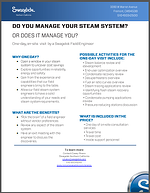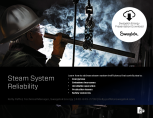Share this
Technical Webinar Replay: Steam System Reliability with Kelly Paffel
by Jeff Hopkins on 8/26/15 8:00 AM
If you weren't able to watch it live, here's a second chance to learn from an expert
One of the hallmarks of our classes, seminars and webinars is that we call on industry experts to present the material. For our recent webinar on Steam System Reliability, for instance, we had the expertise of Kelly Paffel, technical manager for Swagelok Energy Advisors. With more than four decades of experience in steam, compressed air systems and power operations, he's recognized worldwide as an authority in industrial steam systems.
If you missed out on hearing Paffel live, we're giving you a second chance by putting the presentation online.
For this webinar, Paffel looked at two main reliability areas: steam leakage and component failure. For those who oversee other compressed gas systems and not steam, while steam and other compressed gasses may act differently within your systems, the ideas presented in this webinar of conserving these gasses and preventing leaks can carry over beyond just steam.
Steam leakage
Steam leakage is going to hurt any plant in five different ways. First, it's a safety problem. Second, lost steam means lost energy, as much as 19 percent of the energy produced. Third -- and this is one people often forget -- leaking steam is an emissions problem. After all, whatever you are burning to create the steam, you have to burn more of it to compensate for the leak. That means more emissions.
Put all of those together and you get the fourth problem, loss of reliability. That, in turn, creates the fifth problem, interruptions in production.
Paffel examined each of these five areas in detail. He also has some useful approaches for estimating the size of a steam leak. That's always a challenge, because it almost always involves an orifice with an irregular shape. Paffel goes through ways to get a rough idea of what a steam leak will cost over the course of a year.
No matter how big it is when you find it, however, it's a safe bet that the leak will only get worse if it isn't fixed right away.
Ideally, the best way to deal with leaks is preventing them from happening in the first place. What causes steam leaks? Corrosion is a big reason, but not the only one. Poor installation, selecting the wrong components, and poor operation of the steam system can all cause leaks.
Component Failure
When a whole component fails, such as a hose or a valve that gives way, it causes the same kinds of problems, only more immediate.
The most obvious problem with component failure is downtime. But, just as with steam leaks, one problem leads to another. Downtime means lost production. It also means spending maintenance dollars. And, since it means steam is blowing out, you get all the safety and emissions problems associated with a leak.
If a component fails on a tracing system, it means losing temperature because of the lower pressure. Other key areas of component failure are heat transfer tubes, PRV valves, control valves, turbines, condensate pumps and expansion devices.
Make sure every component installed in the steam system is properly rated for the job, Paffel said, and component failure will become a much smaller problem.
The most important thing of all, however, isn't a question of equipment, it's a question of behavior. The most important aspect of improving reliability is change. Don't expect to do things the way they were done 15 years ago, 10 years ago or even five years ago. That includes everything from the engineering specification and system design to standard operating procedures.
No steam system should have more than six leak points a year, Paffel said, and every steam component should last at least six years.
It takes only a few minutes to read this summary. For the full 20-minute webinar, click here. You can hear Paffel and see his slides, and you can keep a transcript for future reference. So don't get steamed by the leaks and component failures in your system.
Additional Resources
 |
 |
|
| Energy Management Services | Energy Engineer Site Visit | |
Share this
- Archive (465)
- Assembly Services (207)
- About (100)
- Seal Support Systems (96)
- Best Practices (88)
- Training Services (74)
- Fittings (51)
- Semiconductor Applications (49)
- Hoses and Flexible Tubing (47)
- Regulators (44)
- Tubing (42)
- Grab Sampling Systems (32)
- Sampling Systems (32)
- Gas Systems (30)
- Services (30)
- Downloads (29)
- Valves (24)
- Application Support (18)
- Orbital Welding (17)
- Case Studies (13)
- Steam Systems (13)
- Frequently Asked Questions (12)
- Tools (12)
- Measurement Devices (7)
- Subsystems (6)
- Thermal Management (6)
- September 2023 (1)
- August 2023 (2)
- June 2023 (1)
- March 2023 (3)
- February 2023 (3)
- January 2023 (4)
- December 2022 (4)
- November 2022 (4)
- October 2022 (4)
- September 2022 (1)
- August 2022 (3)
- July 2022 (2)
- June 2022 (4)
- May 2022 (1)
- April 2022 (2)
- March 2022 (1)
- February 2022 (2)
- January 2022 (3)
- December 2021 (1)
- November 2021 (6)
- October 2021 (6)
- September 2021 (8)
- August 2021 (4)
- July 2021 (3)
- June 2021 (6)
- May 2021 (6)
- April 2021 (7)
- March 2021 (5)
- February 2021 (4)
- January 2021 (6)
- December 2020 (5)
- November 2020 (6)
- October 2020 (6)
- September 2020 (8)
- August 2020 (7)
- July 2020 (8)
- June 2020 (8)
- May 2020 (6)
- April 2020 (9)
- March 2020 (7)
- February 2020 (10)
- January 2020 (21)
- December 2019 (23)
- November 2019 (21)
- October 2019 (22)
- September 2019 (21)
- August 2019 (22)
- July 2019 (23)
- June 2019 (20)
- May 2019 (23)
- April 2019 (22)
- March 2019 (21)
- February 2019 (20)
- January 2019 (21)
- December 2018 (14)
- November 2018 (19)
- October 2018 (23)
- September 2018 (17)
- August 2018 (29)
- July 2018 (11)
- June 2018 (6)
- May 2018 (5)
- April 2018 (4)
- March 2018 (5)
- February 2018 (3)
- January 2018 (3)
- December 2017 (2)
- November 2017 (4)
- October 2017 (3)
- September 2017 (2)
- August 2017 (6)
- July 2017 (4)
- June 2017 (4)
- May 2017 (4)
- April 2017 (3)
- March 2017 (4)
- February 2017 (3)
- January 2017 (3)
- December 2016 (3)
- November 2016 (3)
- October 2016 (3)
- September 2016 (5)
- August 2016 (5)
- July 2016 (4)
- June 2016 (5)
- May 2016 (3)
- April 2016 (4)
- March 2016 (5)
- February 2016 (11)
- January 2016 (1)
- December 2015 (3)
- November 2015 (4)
- October 2015 (3)
- September 2015 (4)
- August 2015 (4)
- July 2015 (8)
- June 2015 (5)
- May 2015 (3)
- April 2015 (4)
- March 2015 (4)
- February 2015 (3)
- January 2015 (4)
- December 2014 (2)
- November 2014 (3)
- October 2014 (4)
- September 2014 (4)
- August 2014 (4)
- July 2014 (5)
- June 2014 (4)
- May 2014 (4)
- April 2014 (5)
- March 2014 (4)
- February 2014 (3)
- January 2014 (4)
- December 2013 (5)
- November 2013 (3)
- October 2013 (4)
- September 2013 (3)
- August 2013 (5)
- July 2013 (5)
- June 2013 (5)
- May 2013 (3)
- April 2013 (6)
- March 2013 (4)
- February 2013 (4)
- January 2013 (8)
- December 2012 (4)
- November 2012 (6)
- October 2012 (6)
- September 2012 (4)
- August 2012 (4)
- July 2012 (4)
- June 2012 (4)

.webp?width=210&height=70&name=StickyLogo%20(5).webp)
